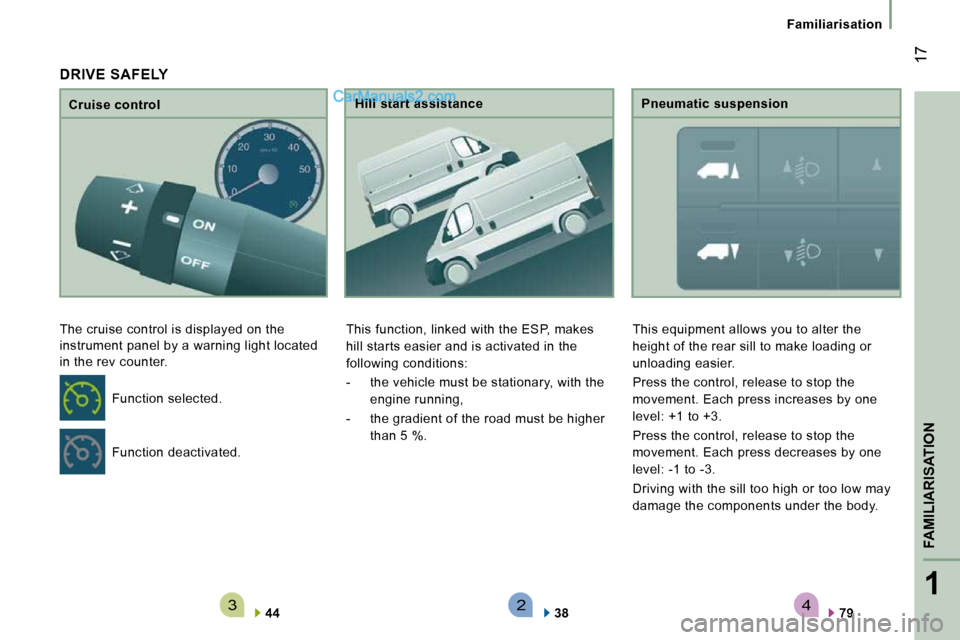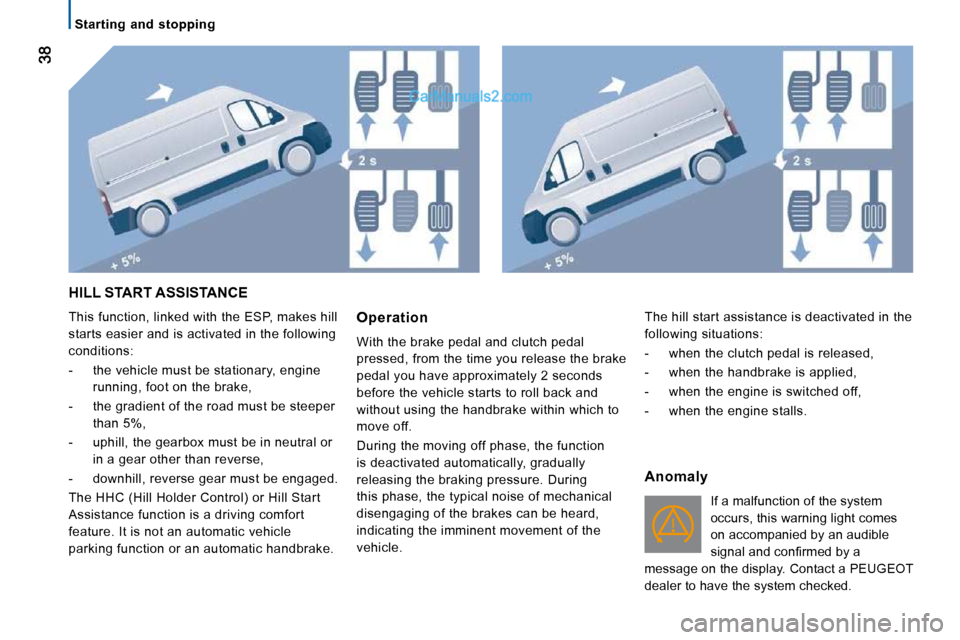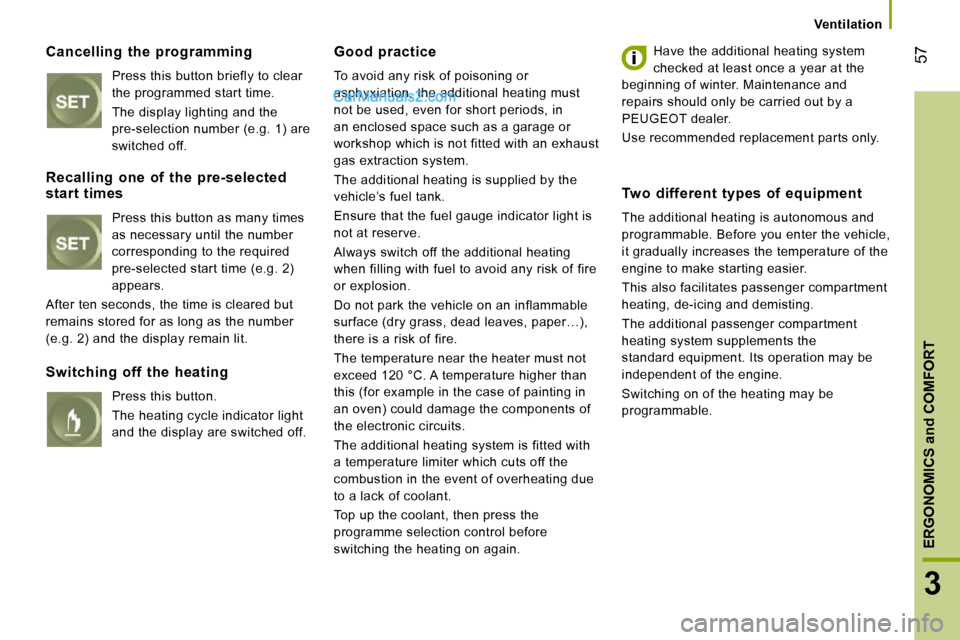ESP Peugeot Boxer 2008.5 Owner's Manual
[x] Cancel search | Manufacturer: PEUGEOT, Model Year: 2008.5, Model line: Boxer, Model: Peugeot Boxer 2008.5Pages: 167, PDF Size: 4.17 MB
Page 1 of 167

4
PRESENTATION
Within the chapters symbols draw your attention to specific
information:
This handbook is designed to familiarise you with
the new vehicle
from the moment you get behind the wheel and to des cribe the
operating features.
Reading the handbook is made easy by a content con sisting of
10 identified chapters which can be located by mean s of a colour
code specific to each one. Its sections cover, by t heme, all of the
functions of the vehicle in its most complete speci fication.
Chapter 9 indicates all of the technical data rela ting to your
vehicle. At the end of the document, diagrams of th e outside
and inside of the vehicle will assist you in locati ng equipment or
functions and page numbers refer you to the relevan t section of
the handbook.
PEUGEOT COMMUNICATION PUTS AN INTERNET SITE AT YOUR DISPOSAL
http://public.servicebox.peugeot.com , select:
- the vehicle documentation/handbooks item,
- your model,
- the body type: saloon, CC, SW, estate, van, …,
- the period corresponding to the date of first registration,
- the "Latest Information" section.
The technical data, equipment and accessories may
change
during the year. To obtain this new data, refer to the "Latest
Information" section on the SERVICEBOX Internet site.
Simple registration permits access to the site and free
consultation of the vehicle documentation. directs you to the chapter and section which conta
ins detailed
information concerning a function,
indicates important information relating to use of the equipment,
alerts you to the safety of individuals and equipm ent on board.
Page 14 of 167

4321
FAMILIARISATION
17
Familiarisation
Cruise control
The cruise control is displayed on the
instrument panel by a warning light located
in the rev counter.
44 Hill start assistance
This function, linked with the ESP, makes
hill starts easier and is activated in the
following conditions:
- the vehicle must be stationary, with the engine running,
- the gradient of the road must be higher than 5 %.
38 Pneumatic suspension
This equipment allows you to alter the
height of the rear sill to make loading or
unloading easier.
Press the control, release to stop the
movement. Each press increases by one
level: +1 to +3.
Press the control, release to stop the
movement. Each press decreases by one
level: -1 to -3.
Driving with the sill too high or too low may
damage the components under the body.
79
Function deactivated.
Function selected.
DRIVE SAFELY
Page 27 of 167

Instruments and controls
30
Warning light is indicates Solution - action
ESP flashing. that it is in operation.
on.
its malfunction or failure of the
hill start assistance. Consult a PEUGEOT dealer.
Refer to the "Driving safety" section of chapter 5.
Emission control
system on. failure of the system. Have the system checked by a PEUGEOT dealer
without delay.
Anti-pollution on. failure of the system. Have the system checked by a PEUGEOT dealer
without delay.
Disarming of the
front passenger
air bag on. the intentional disarming of this
air bag when a rear facing child
seat is installed. Configure via the trip computer MODE menu. Refer t
o
the "Mode" section of chapter 4.
Electronic
immobiliser on. the ignition key inserted is not
recognised.
The vehicle cannot be started. Use another key and have the faulty key checked by
a
PEUGEOT dealer. Refer to the "Accesses" section of
chapter 2.
Front brake
pads on. brake pad wear. Have the pads replaced by a
PEUGEOT dealer.
Page 35 of 167

Starting and stopping
HILL START ASSISTANCE
This function, linked with the ESP, makes hill
starts easier and is activated in the following
conditions:
- the vehicle must be stationary, engine running, foot on the brake,
- the gradient of the road must be steeper than 5%,
- uphill, the gearbox must be in neutral or in a gear other than reverse,
- downhill, reverse gear must be engaged.
The HHC (Hill Holder Control) or Hill Start
Assistance function is a driving comfort
feature. It is not an automatic vehicle
parking function or an automatic handbrake. Operation
With the brake pedal and clutch pedal
pressed, from the time you release the brake
pedal you have approximately 2 seconds
before the vehicle starts to roll back and
without using the handbrake within which to
move off.
During the moving off phase, the function
is deactivated automatically, gradually
releasing the braking pressure. During
this phase, the typical noise of mechanical
disengaging of the brakes can be heard,
indicating the imminent movement of the
vehicle.
Anomaly
If a malfunction of the system
occurs, this warning light comes
on accompanied by an audible
�s�i�g�n�a�l� �a�n�d� �c�o�n�fi� �r�m�e�d� �b�y� �a�
message on the display. Contact a PEUGEOT
dealer to have the system checked.
The hill start assistance is deactivated in the
following situations:
- when the clutch pedal is released,
- when the handbrake is applied,
- when the engine is switched off,
- when the engine stalls.
Page 36 of 167

Starting and stopping
HILL START ASSISTANCE
This function, linked with the ESP, makes hill
starts easier and is activated in the following
conditions:
- the vehicle must be stationary, engine running, foot on the brake,
- the gradient of the road must be steeper than 5%,
- uphill, the gearbox must be in neutral or in a gear other than reverse,
- downhill, reverse gear must be engaged.
The HHC (Hill Holder Control) or Hill Start
Assistance function is a driving comfort
feature. It is not an automatic vehicle
parking function or an automatic handbrake. Operation
With the brake pedal and clutch pedal
pressed, from the time you release the brake
pedal you have approximately 2 seconds
before the vehicle starts to roll back and
without using the handbrake within which to
move off.
During the moving off phase, the function
is deactivated automatically, gradually
releasing the braking pressure. During
this phase, the typical noise of mechanical
disengaging of the brakes can be heard,
indicating the imminent movement of the
vehicle.
Anomaly
If a malfunction of the system
occurs, this warning light comes
on accompanied by an audible
�s�i�g�n�a�l� �a�n�d� �c�o�n�fi� �r�m�e�d� �b�y� �a�
message on the display. Contact a PEUGEOT
dealer to have the system checked.
The hill start assistance is deactivated in the
following situations:
- when the clutch pedal is released,
- when the handbrake is applied,
- when the engine is switched off,
- when the engine stalls.
Page 38 of 167

40
Steering wheel controls
LIGHTING CONTROL
Selection is by rotation of the white mark on
the ring.
All lights off
Direction indicators (green flashing)
Left: downwards.
Right: upwards.
STEERING WHEEL CONTROLS
Side lights on
Dipped headlamps/main beam headlamps on
Dipped headlamps/main beam headlamps change
Pull the control fully towards you.
Headlamp flash
Pull the control towards you, regardless of
the position of the ring.
Front fog lamps
Rear fog lamps
If your vehicle is fitted with fog lamps, these
operate with the side lights, the dipped
headlamps or the main beam headlamps.
Press one of these controls to switch on the
lights. The fog lamps should only be used in
fog or when snow is falling.
In clear weather or in rain, both day and
night, lit rear fog lamps dazzle and are
prohibited.
Do not forget to switch them off when they
are no longer necessary.
"Motorway" function
Pull the lever towards the steering wheel
with a press, without passing the point
of resistance of the lights stalk; the
corresponding direction indicators will flash
five times.
Page 43 of 167

45
3
ERGONOMICS and COMFORT
Steering wheel controls
Selecting the function - ON
When the selection is set
to ON , this switches the
function on.
If your vehicle is fitted with this display, a
message confirms the action.
Programming a speed
Accelerate to the required speed, with 4th or
5th gear engaged.
Move the control upwards (+), for
approximately one second, to store this
speed.
Release the pressure on the accelerator
pedal, the vehicle will maintain this speed.
Switching off/deactivating the function
Press the brake or clutch pedal or place the
dial in the OFF position, the indicator light is
switched off.
If the ESP or ASR comes into operation,
the cruise control function is deactivated
temporarily.
- increase the speed in steps, by means of brief presses, or continuously by
pressing and holding the control
upwards ( + sign),
Temporary exceeding of the speed
When the cruise control is active, it is still
possible to exceed the programmed speed
by pressing the accelerator pedal
(to overtake another vehicle for example).
- decrease the speed continuously by pressing and holding the control
downwards (- sign).
Restore - RES
To restore the vehicle’s
programmed speed (for example
after pressing the brake or clutch
pedal), gradually return to the chosen speed
and press RES .
The indicator light comes on, the cruise
control function is restored.
Changing the programmed speed
while the cruise control is in operation
You can:
Page 44 of 167

46
Steering wheel controls
Good practice
When changing the programmed reference
speed by pressing and holding the control,
take care as the speed may increase or
decrease rapidly.
Do not use the cruise control on slippery
roads or in heavy traffic.
On a steep gradient, the cruise control will
not be able to prevent the vehicle from
exceeding the programmed speed.
The cruise control cannot, in any
circumstances, replace the need to comply
with speed limits nor can it replace the need
for vigilance and responsibility on the part
of driver.
It is advisable to leave your feet near the
pedals.
To prevent the mat from becoming caught
under the pedals:
- ensure that the mat is positioned correctly,
- never fit one mat on top of another.
Cancelling the programmed speed
When the vehicle stops, after the ignition is
switched off, the system no longer stores
any speed.
Operating fault
In the event of a malfunction, the function
is switched off and the indicator light
switches off.
Contact a PEUGEOT dealer to have the
system checked.
Page 54 of 167

56
Ventilation
Setting the time of the internal clock
Set the clock on the control panel before
programming the deferred switching on of
the heating.
Immediate switching on of the heating
Before switching on the heating, check that:
- the temperature setting control is in the "Hot air" position (red).
� � �-� � �t�h�e� �a�i�r� �fl� �o�w� �s�e�t�t�i�n�g� �c�o�n�t�r�o�l� �i�s� �i�n� �p�o�s�i�t�i�o�n� �2�. � �
This symbol or the previous stored time
and the number (e.g. 1) corresponding to
the recalled pre-selection are displayed for
ten seconds.
Note: if you wish to recall the other pre-
selected times, press the SET button several
times before the ten seconds have elapsed.
Press this button.
The display and the associated
indicator light come on.
Within ten seconds, press these two setting
buttons until the correct time is displayed.
Press ">" to increase the hours or
"<" to decrease.
Press and hold the button for
more rapid scrolling of the digits.
Reading the time
Press this button.
This indicator light comes
on, the time is displayed for
approximately ten seconds. Press this button.
The display and the heating
cycle indicator light come on
and remain on throughout the
duration of operation.
Switching on the deferred heating
Switching on can be programmed between
one minute and twenty-four hours in
advance.
You can store up to three different start
times, but programme one deferred start
only.
Note : if you wish to start the heating at a
fixed time each day, simply reprogramme
the stored time each day.
Press this button, the display
becomes overbright. Within the ten seconds, press
these two setting buttons to
select the required start time.
Setting of the stored time
is confirmed by clearing of
the start time, displaying of the
pre-selection number (e.g. 1)
and overbrightness of the display
lighting.
Page 55 of 167

57
3
ERGONOMICS and COMFORT
Ventilation
Cancelling the programming
Press this button briefly to clear
the programmed start time.
The display lighting and the
pre-selection number (e.g. 1) are
switched off.
Good practice
To avoid any risk of poisoning or
asphyxiation, the additional heating must
not be used, even for short periods, in
an enclosed space such as a garage or
workshop which is not fitted with an exhaust
gas extraction system.
The additional heating is supplied by the
vehicle’s fuel tank.
Ensure that the fuel gauge indicator light is
not at reserve.
Always switch off the additional heating
when filling with fuel to avoid any risk of fire
or explosion.
Do not park the vehicle on an inflammable
surface (dry grass, dead leaves, paper…),
there is a risk of fire.
The temperature near the heater must not
exceed 120 °C. A temperature higher than
this (for example in the case of painting in
an oven) could damage the components of
the electronic circuits.
The additional heating system is fitted with
a temperature limiter which cuts off the
combustion in the event of overheating due
to a lack of coolant.
Top up the coolant, then press the
programme selection control before
switching the heating on again. Have the additional heating system
checked at least once a year at the
beginning of winter. Maintenance and
repairs should only be carried out by a
PEUGEOT dealer.
Use recommended replacement parts only.
Recalling one of the pre-selected start times
Press this button as many times
as necessary until the number
corresponding to the required
pre-selected start time (e.g. 2)
appears.
After ten seconds, the time is cleared but
remains stored for as long as the number
(e.g. 2) and the display remain lit.
Switching off the heating
Press this button.
The heating cycle indicator light
and the display are switched off.
Two different types of equipment
The additional heating is autonomous and
programmable. Before you enter the vehicle,
it gradually increases the temperature of the
engine to make starting easier.
This also facilitates passenger compartment
heating, de-icing and demisting.
The additional passenger compartment
heating system supplements the
standard equipment. Its operation may be
independent of the engine.
Switching on of the heating may be
programmable.